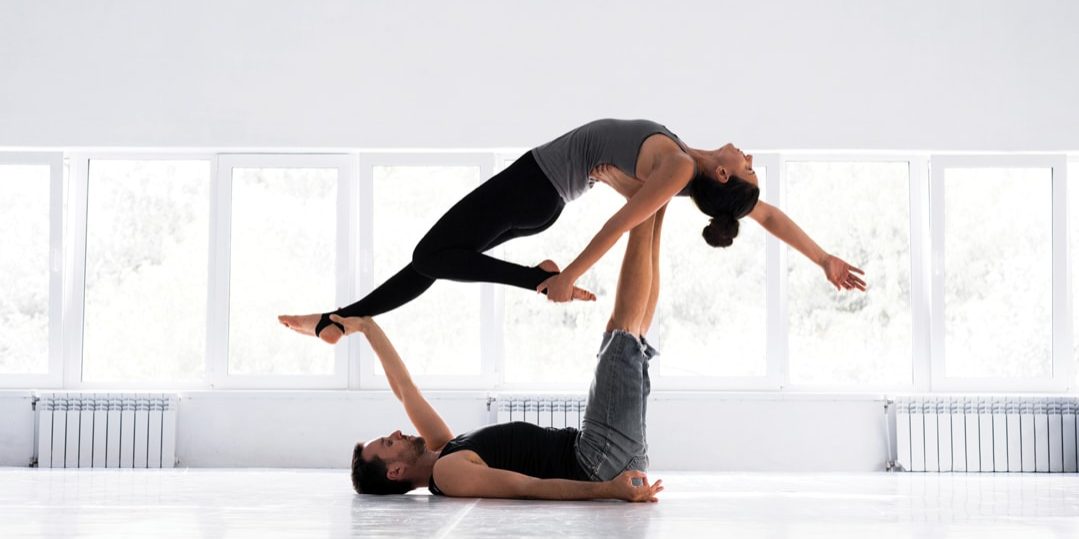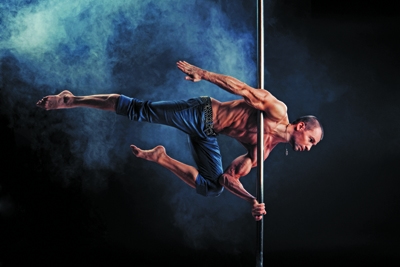
Acro Yoga: a brief history
Are you a yoga purist? The ancient origins of Pole Yoga and Acro Yoga may surprise you, writes Patrick McCartney
For the purist, many hybrid forms of yoga stray too far from what is considered an authentic and traditional concept of yoga. Yet, throughout history, multiple styles and schools of yoga existed and were often in direct competition.
It is not accurate to say that a singular, traditional and authentic ‘yoga’ existed, or that our aim should be to return to a pure ideal.
Think about any number of yoga hybrids available today. Some obvious examples include: SUP Yoga, Beer Yoga, Weed Yoga, HIIT Yoga, or Egyptian Yoga. While some people celebrate the diversity and options available in the yoga marketplace, others lament it for the same reason.
Some, more subtle, hybrids are Iyengar and Ashtanga Yoga. For many, these brands represent what otherwise might be considered the gold standard of traditional yoga. Yet, even just for the simple fact of combining a ‘Vinyasa Flow’ is evidence of hybridity such as acro yoga
If one reads Patanjali’s sutra 4.1, on the different ways to attain samadhi, the term aushadhi (herbs) can be read to include these perceived modern aberrations as part of a yoga tradition. Even the ayurvedic texts of Sushruta and Charaka reference cannabis as aushadhi. As well, there are multiple instructions about how to make restorative alcoholic beverages and tonics. The case could be made that Beer or Weed Yoga are closer to some idea of tradition than is often accepted.
Acro Yoga
Acro Yoga and Pole Yoga are two hybrids that often come under fire from traditionalists. I am about 18 months into a research project that initially began with looking at Mallakhamb and any relationship to the historical development of Hatha Yoga. Today, Mallakhamb is an internationally federated sport seeking Olympic inclusion. It is a Marathi term that appears about 250 years ago, which literally means 'Wrestler-pole’.
The wrestler’s pole is a training apparatus that wrestlers would use in the evenings. This allied with 'tumbling’ exercises similar to any form of acrobatic exercise that has similarities with Acro Yoga.; particularly, the exercises that require one wrestler to climb on top of another wrestler.
Generally, it is difficult to find much written in Sanskrit (or other Indian languages). Since information is limited, the biographies have evolved based more on imagination than fact.
Our current understanding of Mallakhamb begins with a book published in the 1920s which also begins incorporating Hatha Yoga within a Mallakhamb context. Around 1800, Mallakhamb is said to have been revived in Pune. Prior to this, it appears in two Sanskrit texts. The Mallapurana was possibly first written in the 13th century, yet the only two copies we have now provide a date of being written sometime in the 18th century. Mallakhamb is known by the term stambhashrama, which means pole exercise. Both stambha and khamba mean 'pole’.
I consider it possibly existed, in some form, and by some other name, perhaps, prior to its mention in the 12th century Manasollasa. If that is the case, what, then, might it be known as? More importantly, where should someone start looking? For a very long time there have been wandering troupes of performers. These circus-like groups included a mix of strong, agile, coordinated people who needed to multi-task and switch roles. These groups consisted of wrestlers, dancers, acrobats, jesters, musicians, magicians, snake charmers, actors, comedians, and hosts/MCs.
Several words used to define one of these occupations is similarly used to define many of the others. This means that wrestlers did more than just wrestle. The same goes for the others. Yet, the wrestlers quite often danced and performed mountebank style tumbling/ acrobatic displays, climbed poles to dance and walk tightropes.
These individual troupes may have found employment from royal courts. Many royal bookkeeping accounts mention how pension plans show how wrestlers and dancers were often classified similar to actors and singers as ‘stage performers’. If these performers, who were often held in very high regard, and were often lavished with great wealth and land by kings impressed by their skills, were not offered a royal contract, they would return to touring the circuit, which seems to have extended into Central Asia, at least, and possibly beyond.
Some dancers were considered important enough to have memorial stones created. One rather tragic example is located on the southern bank of the Jayamangali river, which runs through the town of Koraṭagere, Tumkur District, Karnataka. The stone is a memorial to the spot where a young woman, Yellakka, died, sometime during the early 17th century. While dancing atop a bamboo, she fell. The stone’s message translates to: “A certain female tumbler climbed a bamboo pole, turned somersaults thereon, and balanced herself on the tip of the pole, danced and sang.”
There are some fascinating artworks showcasing wrestlers, acrobats, and dancers climbing poles for performance or training from yesteryear. They are part of the Ragamala genre of art and are specifically known as Deshakh series, which appeared in the 1500s and depict various scenes in the 1800s.
During the colonial-era, documents there are many descriptions of various ‘criminal castes,’ as they came to be classified. One particular group was the ‘Kham Gopals’. This nomadic group of pole climbing (kham) and wrestling cow herders (Gopal) would erect a tall bamboo pole. Rare video footage from 1929 shows this performance.
While wrestling was popular entertainment, the pole dancing acts also drew a crowd. These bamboo poles could be several metres tall. In my mind, I imagine a situation where the wrestler-acrobats were being teased by the more prestigious royal wrestlers, who possibly shared the same gymnasium to train and rehearse in.
I imagine the wrestlers claiming to be stronger than the wrestler-acrobat and, at some point, a challenge is made.

Perhaps it was a simple wrestling match or maybe a challenge to climb a pole. Or, maybe it was friendlier, and it became obvious that people who climbed up and down poles developed a superior physique to those who did not, which was then adopted into the official training regime of wrestlers.
While I am still in the tedious process of searching for difficult to locate manuscripts and other sources, one thing is already quite clear. These groups, especially the pole dancing acrobat-wrestlers, existed long before the 12th century. There is even evidence found in one of the four Vedas.
The Shukla Yajurveda mentions a particular class of people who are referred to by the term, vamsha-nartin, which literally means bamboo pole-dancing. It describes professional women who climb a pole and dance across the sky.The approximate time stamp of the Yajurveda ranges between 1200-800 BCE. That is approximately 2400 years before stambhashrama is mentioned.
We know that people have climbed poles and professionally performed tumbling- acrobatic and wrestling displays for a long time. We know that the physical requirements of circus performers have, even in Europe, led to the development of the first gymnastic manuals in the 1500s, eventually evolving into modern calisthenics, like the Swedish system of Pehr Henrik Ling, which played some part in the rapid development of modern yoga hybrids over the past 150 years.
This brings us full circle, in some sense, as it is possible that a trans-continental network spanning Europe and Asia existed between circus performers. It is likely influenced by the descendants of the Roma in Europe, today, whose ancestors are related to the similar troupes of dancer-acrobat-wrestlermusicians in Iran known as the Toma, and the similar groups in India known as the Doma, which can be traced all the way back to the bamboo pole dancing outcastes from 3200 years ago, known as Candalas.
Even though the early origins of Hatha Yoga are now considered to have emerged in Buddhist tantric texts from the 10-11th centuries and mature around the 15th century, there is some room to ponder, at least, how these strong, athletic pole dancing wrestler-acrobats might have influenced more than just stambhashrama and Mallakhamb, but possibly, also, aspects of Hatha Yoga’s repertoire of postures and embodied practice, and, Acro yoga and Pole Yogas.
The final point to consider is that any attempt to delegitimise any yoga hybrid, by categorising it as a modern, non-traditional aberration, is difficult to justify. Suggestions, similar to ‘this is not yoga’, expose a general level of misinformation that is, upon closer inspection, difficult to support. Yoga is not a static and singular thing. It is, today, as plural, dynamic, and complex as it has ever been.
Patrick McCartney is a writer and film maker interested in the documenting biographies of yoga and Sanskrit. Find him at: patrickmccartney.academia.edu


